SUBARU OUTBACK 2005 4.G Owners Manual
Manufacturer: SUBARU, Model Year: 2005, Model line: OUTBACK, Model: SUBARU OUTBACK 2005 4.GPages: 627, PDF Size: 6.42 MB
Page 111 of 627
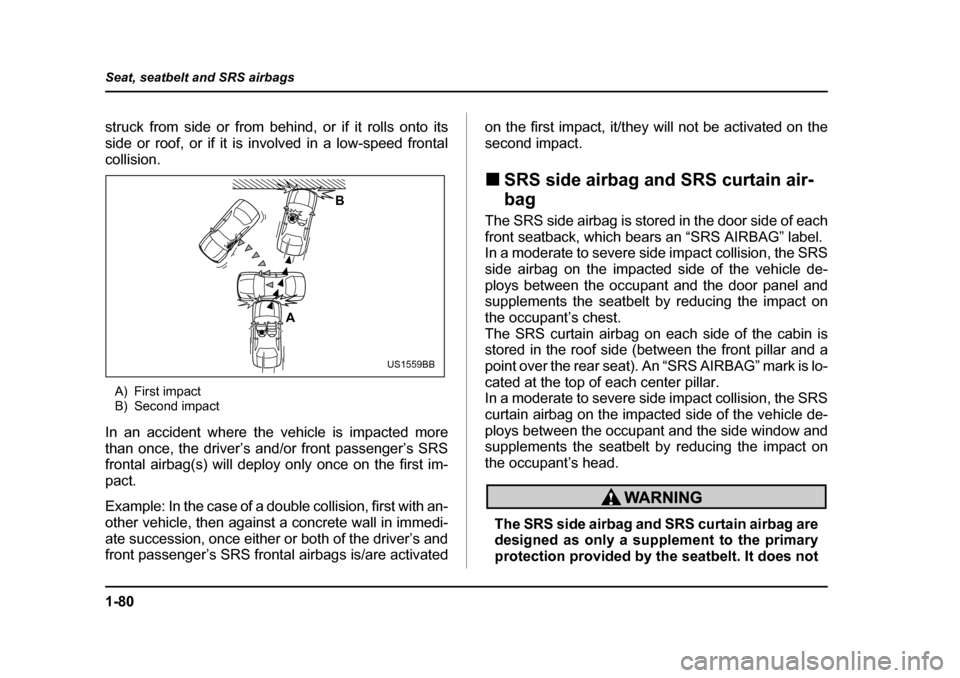
1-80
Seat, seatbelt and SRS airbags
struck from side or from behind, or if it rolls onto its
side or roof, or if it is involved in a low-speed frontal
collision.
A) First impact
B) Second impact
In an accident where the vehicle is impacted more
than once, the driver’s and/or front passenger’s SRS
frontal airbag(s) will deploy only once on the first im-
pact.
Example: In the case of a double collision, first with an-
other vehicle, then against a concrete wall in immedi-
ate succession, once either or both of the driver’s and
front passenger’s SRS frontal airbags is/are activated on the first impact, it/they will not be activated on the
second impact. !
SRS side airbag and SRS curtain air- bag
The SRS side airbag is stored in the door side of each
front seatback, which bears an “SRS AIRBAG” label.
In a moderate to severe side impact collision, the SRS
side airbag on the impacted side of the vehicle de-
ploys between the occupant and the door panel and
supplements the seatbelt by reducing the impact on
the occupant’s chest.
The SRS curtain airbag on each side of the cabin is
stored in the roof side (between the front pillar and a
point over the rear seat). An “SRS AIRBAG” mark is lo-
cated at the top of each center pillar.
In a moderate to severe side impact collision, the SRS
curtain airbag on the impacted side of the vehicle de-
ploys between the occupant and the side window and
supplements the seatbelt by reducing the impact on
the occupant’s head.
The SRS side airbag and SRS curtain airbag are
designed as only a supplement to the primary
protection provided by the seatbelt. It does not
B
A
US1559BB
Page 112 of 627
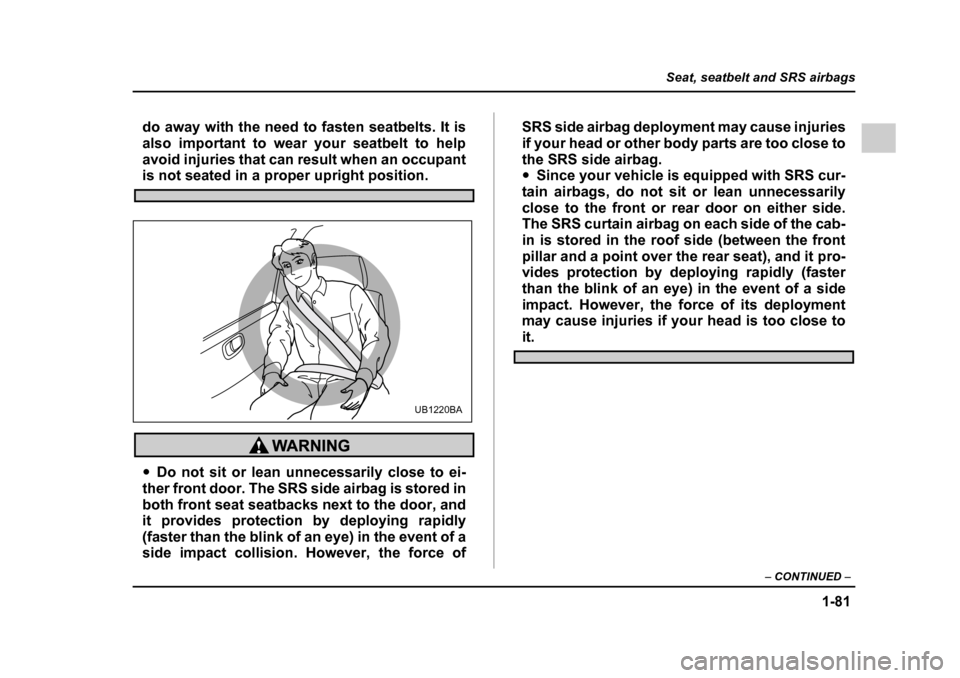
1-81
Seat, seatbelt and SRS airbags
– CONTINUED –
do away with the need to fasten seatbelts. It is
also important to wear your seatbelt to help
avoid injuries that can result when an occupant
is not seated in a proper upright position.
"Do not sit or lean unnecessarily close to ei-
ther front door. The SRS side airbag is stored in
both front seat seatbacks next to the door, and
it provides protection by deploying rapidly
(faster than the blink of an eye) in the event of a
side impact collision. However, the force of SRS side airbag deployment may cause injuries
if your head or other body parts are too close to
the SRS side airbag. "
Since your vehicle is equipped with SRS cur-
tain airbags, do not sit or lean unnecessarily
close to the front or rear door on either side.
The SRS curtain airbag on each side of the cab-
in is stored in the roof side (between the front
pillar and a point over the rear seat), and it pro-
vides protection by deploying rapidly (faster
than the blink of an eye) in the event of a side
impact. However, the force of its deployment
may cause injuries if your head is too close to
it.
UB1220BA
Page 113 of 627
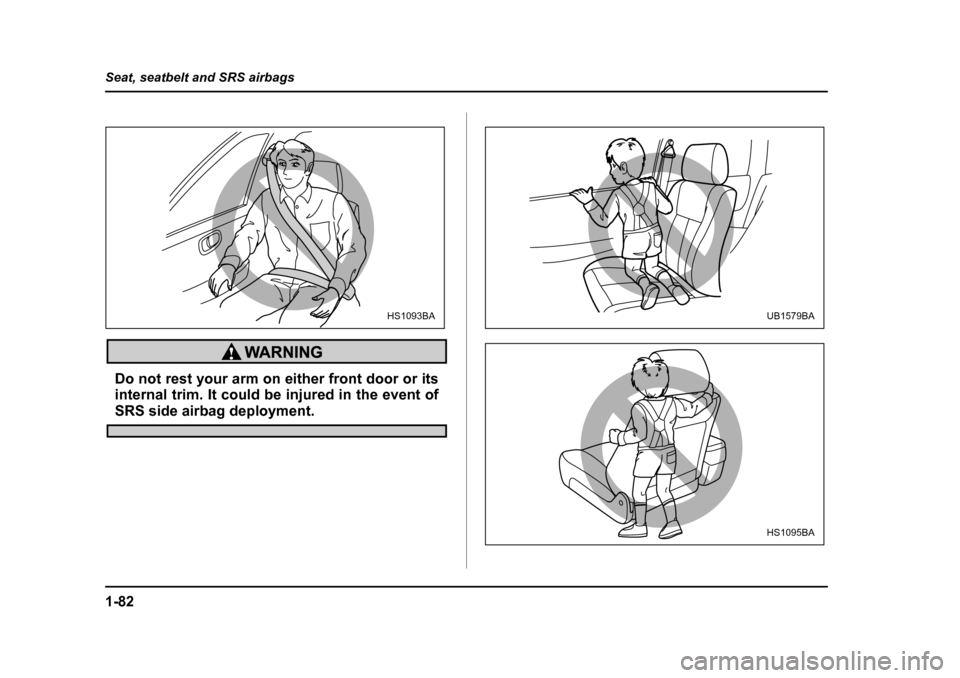
1-82
Seat, seatbelt and SRS airbags
Do not rest your arm on either front door or its
internal trim. It could be injured in the event of
SRS side airbag deployment.
HS1093BAUB1579BA
HS1095BA
Page 114 of 627
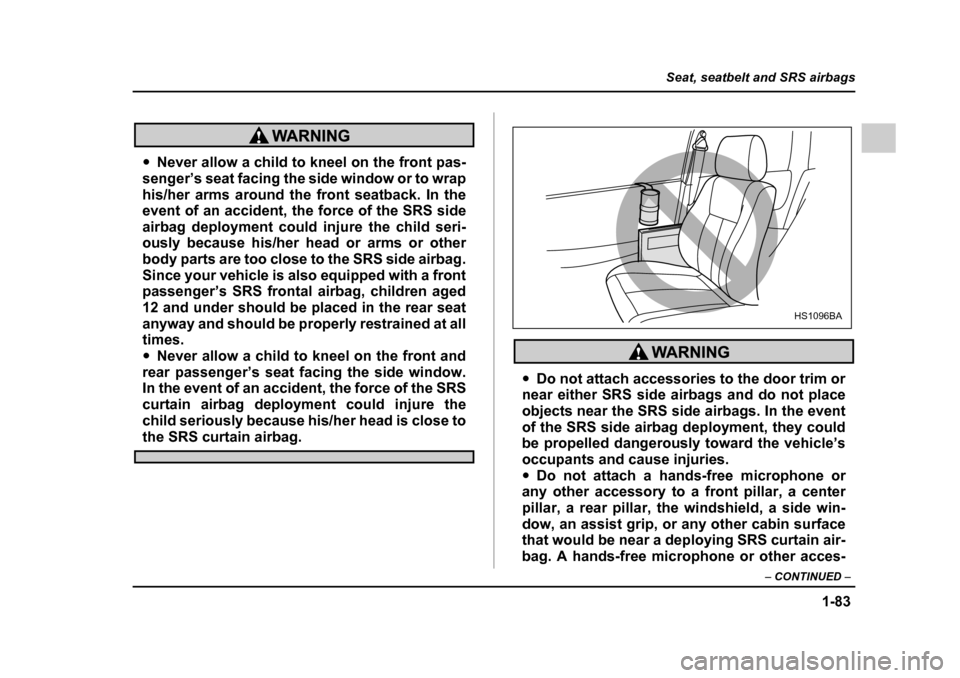
1-83
Seat, seatbelt and SRS airbags
– CONTINUED –
"Never allow a child to kneel on the front pas-
senger’s seat facing the side window or to wrap
his/her arms around the front seatback. In the
event of an accident, the force of the SRS side
airbag deployment could injure the child seri-
ously because his/her head or arms or other
body parts are too close to the SRS side airbag.
Since your vehicle is also equipped with a front
passenger’s SRS frontal airbag, children aged
12 and under should be placed in the rear seat
anyway and should be properly restrained at all times. " Never allow a child to kneel on the front and
rear passenger’s seat facing the side window.
In the event of an accident, the force of the SRS
curtain airbag deployment could injure the
child seriously because his/her head is close to
the SRS curtain airbag.
" Do not attach accessories to the door trim or
near either SRS side airbags and do not place
objects near the SRS side airbags. In the event
of the SRS side airbag deployment, they could
be propelled dangerously toward the vehicle’s
occupants and cause injuries." Do not attach a hands-free microphone or
any other accessory to a front pillar, a center
pillar, a rear pillar, the windshield, a side win-
dow, an assist grip, or any other cabin surface
that would be near a deploying SRS curtain air-
bag. A hands-free microphone or other acces-
HS1096BA
Page 115 of 627
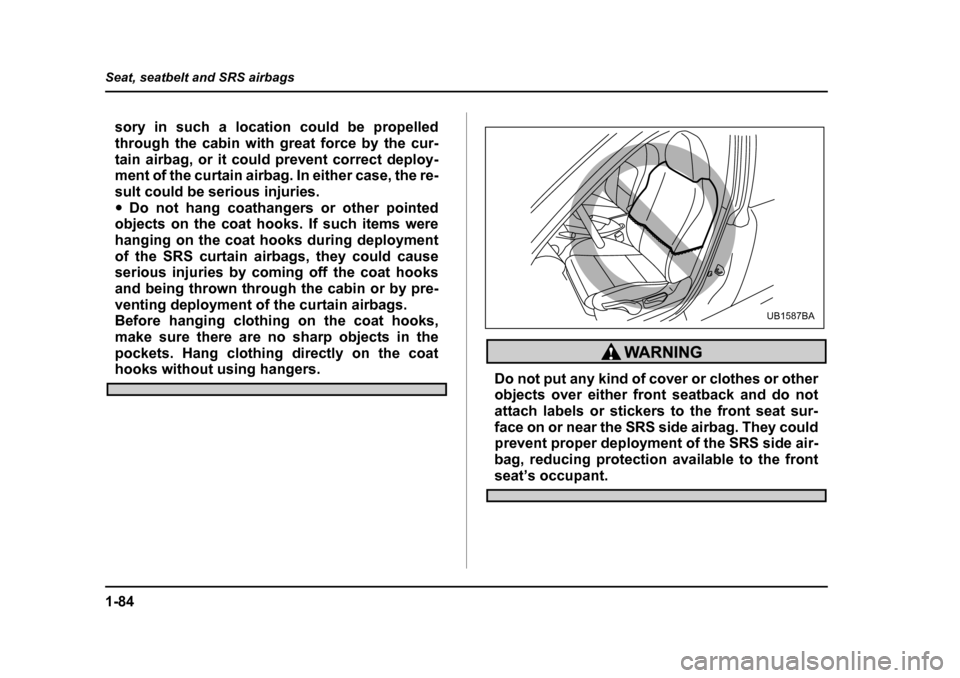
1-84
Seat, seatbelt and SRS airbags
sory in such a location could be propelled
through the cabin with great force by the cur-
tain airbag, or it could prevent correct deploy-
ment of the curtain airbag. In either case, the re-
sult could be serious injuries."
Do not hang coathangers or other pointed
objects on the coat hooks. If such items were
hanging on the coat hooks during deployment
of the SRS curtain airbags, they could cause
serious injuries by coming off the coat hooks
and being thrown through the cabin or by pre-
venting deployment of the curtain airbags.
Before hanging clothing on the coat hooks,
make sure there are no sharp objects in the
pockets. Hang clothing directly on the coat
hooks without using hangers.Do not put any kind of cover or clothes or other
objects over either front seatback and do not
attach labels or stickers to the front seat sur-
face on or near the SRS side airbag. They could
prevent proper deployment of the SRS side air-
bag, reducing protection available to the front
seat’s occupant.
UB1587BA
Page 116 of 627
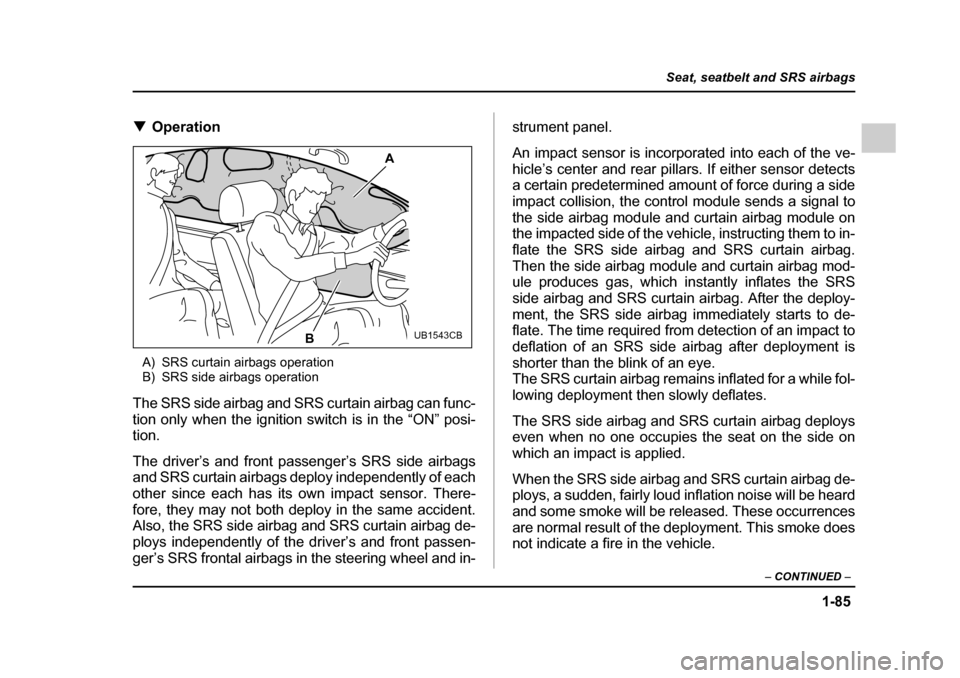
1-85
Seat, seatbelt and SRS airbags
– CONTINUED –
!Operation
A) SRS curtain airbags operation
B) SRS side airbags operation
The SRS side airbag and SRS curtain airbag can func-
tion only when the ignition switch is in the “ON” posi-tion.
The driver’s and front passenger’s SRS side airbags
and SRS curtain airbags deploy independently of each
other since each has its own impact sensor. There-
fore, they may not both deploy in the same accident.
Also, the SRS side airbag and SRS curtain airbag de-
ploys independently of the driver’s and front passen-
ger’s SRS frontal airbags in the steering wheel and in- strument panel.
An impact sensor is incorporated into each of the ve-
hicle’s center and rear pillars. If either sensor detects
a certain predetermined amount of force during a side
impact collision, the control module sends a signal to
the side airbag module and curtain airbag module on
the impacted side of the vehicle, instructing them to in-
flate the SRS side airbag and SRS curtain airbag.
Then the side airbag module and curtain airbag mod-
ule produces gas, which instantly inflates the SRS
side airbag and SRS curtain airbag. After the deploy-
ment, the SRS side airbag immediately starts to de-
flate. The time required from detection of an impact to
deflation of an SRS side airbag after deployment is
shorter than the blink of an eye.
The SRS curtain airbag remains inflated for a while fol-
lowing deployment then slowly deflates.
The SRS side airbag and SRS curtain airbag deploys
even when no one occupies the seat on the side on
which an impact is applied.
When the SRS side airbag and SRS curtain airbag de-
ploys, a sudden, fairly loud inflation noise will be heard
and some smoke will be released. These occurrences
are normal result of the deployment. This smoke does
not indicate a fire in the vehicle.
A
B
UB1543CB
Page 117 of 627
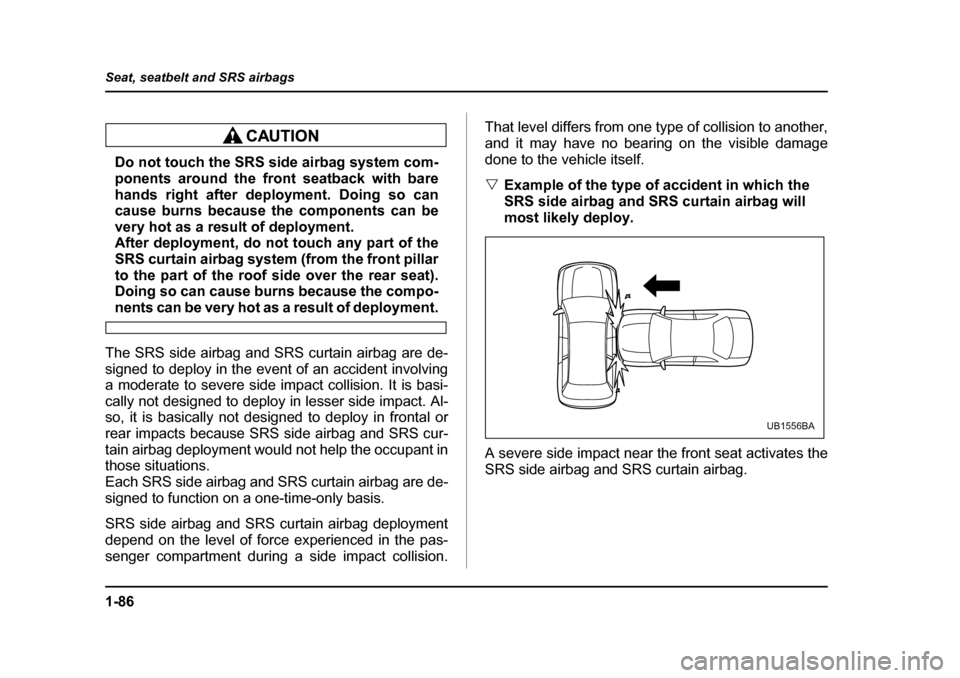
1-86
Seat, seatbelt and SRS airbags
Do not touch the SRS side airbag system com-
ponents around the front seatback with bare
hands right after deployment. Doing so can
cause burns because the components can be
very hot as a result of deployment.
After deployment, do not touch any part of the
SRS curtain airbag system (from the front pillar
to the part of the roof side over the rear seat).
Doing so can cause burns because the compo-
nents can be very hot as a result of deployment.
The SRS side airbag and SRS curtain airbag are de-
signed to deploy in the event of an accident involving
a moderate to severe side impact collision. It is basi-
cally not designed to deploy in lesser side impact. Al-
so, it is basically not designed to deploy in frontal or
rear impacts because SRS side airbag and SRS cur-
tain airbag deployment would not help the occupant in
those situations.
Each SRS side airbag and SRS curtain airbag are de-
signed to function on a one-time-only basis.
SRS side airbag and SRS curtain airbag deployment
depend on the level of force experienced in the pas-
senger compartment during a side impact collision. That level differs from one type of collision to another,
and it may have no bearing on the visible damage
done to the vehicle itself. "
Example of the type of accident in which the
SRS side airbag and SRS curtain airbag will
most likely deploy.
A severe side impact near the front seat activates the
SRS side airbag and SRS curtain airbag.
UB1556BA
Page 118 of 627
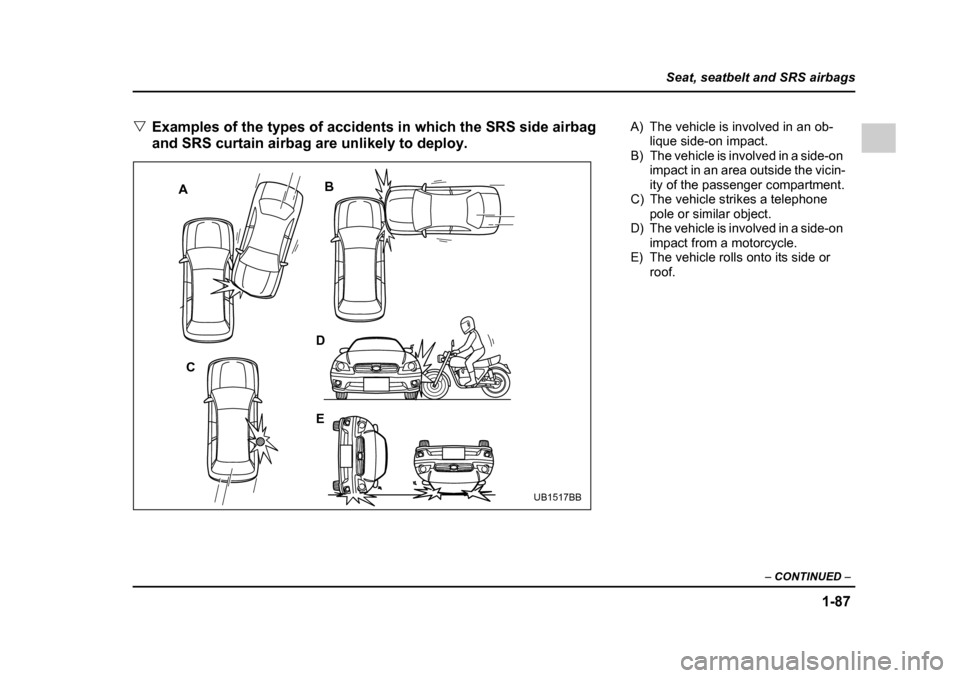
1-87
Seat, seatbelt and SRS airbags
– CONTINUED –
"Examples of the types of accidents in which the SRS side airbag
and SRS curtain airbag are unlikely to deploy.
A B
C D
E
UB1517BB
A) The vehicle is involved in an ob- lique side-on impact.
B) The vehicle is involved in a side-on impact in an area outside the vicin-
ity of the passenger compartment.
C) The vehicle strikes a telephone pole or similar object.
D) The vehicle is involved in a side-on impact from a motorcycle.
E) The vehicle rolls onto its side or roof.
Page 119 of 627
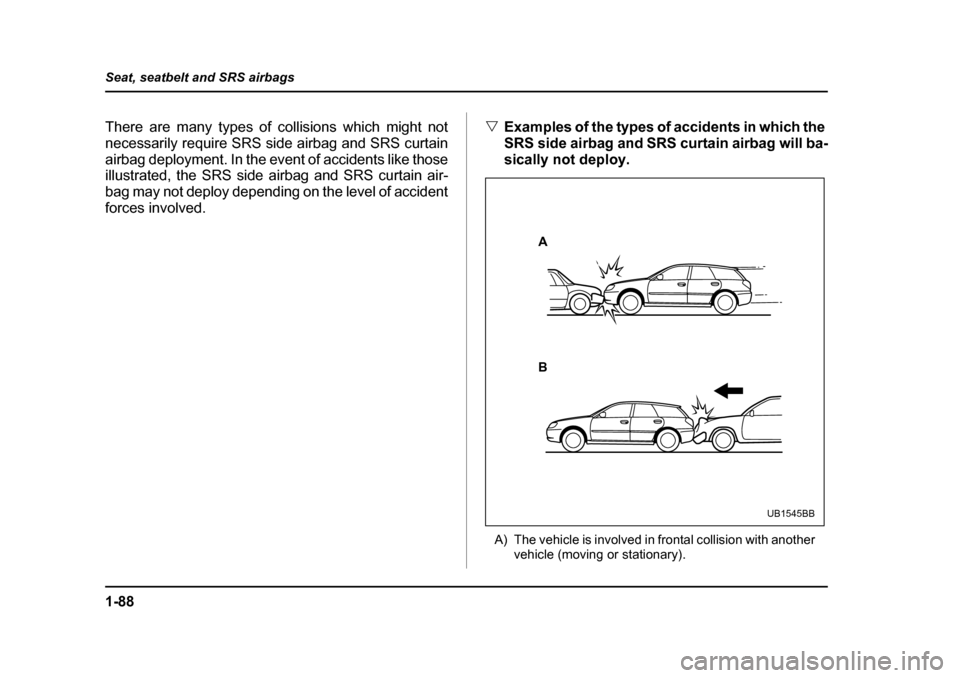
1-88
Seat, seatbelt and SRS airbags
There are many types of collisions which might not
necessarily require SRS side airbag and SRS curtain
airbag deployment. In the event of accidents like those
illustrated, the SRS side airbag and SRS curtain air-
bag may not deploy depending on the level of accident
forces involved.
"
Examples of the types of accidents in which the
SRS side airbag and SRS curtain airbag will ba-
sically not deploy.
A) The vehicle is involved in frontal collision with another vehicle (moving or stationary).
A B
UB1545BB
Page 120 of 627
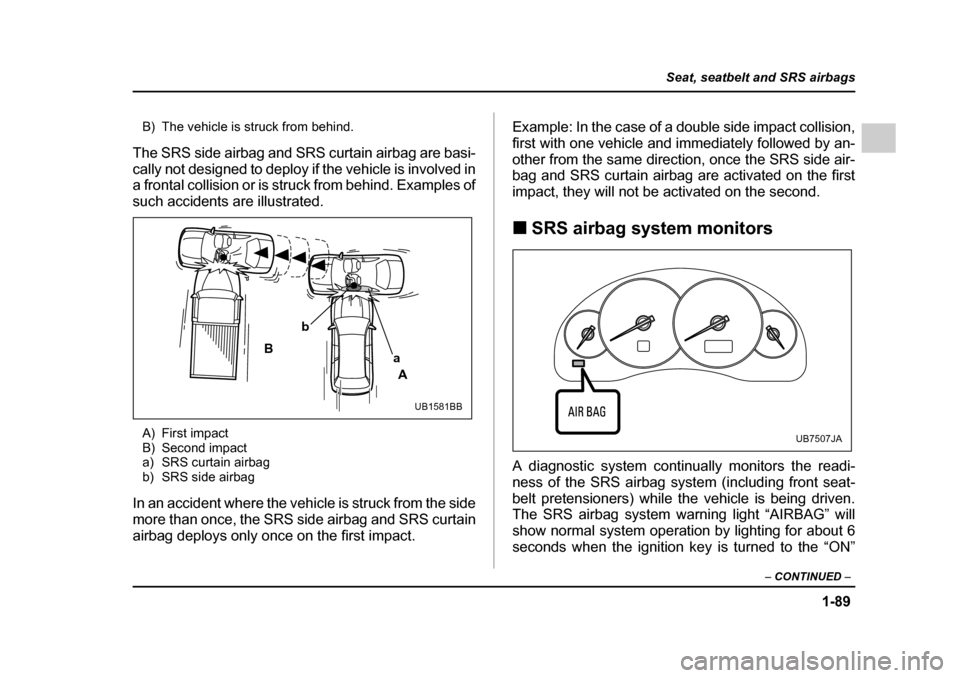
1-89
Seat, seatbelt and SRS airbags
– CONTINUED –
B) The vehicle is struck from behind.
The SRS side airbag and SRS curtain airbag are basi-
cally not designed to deploy if the vehicle is involved in
a frontal collision or is struck from behind. Examples of
such accidents are illustrated.
A) First impact
B) Second impact
a) SRS curtain airbag
b) SRS side airbag
In an accident where the vehicle is struck from the side
more than once, the SRS side airbag and SRS curtain
airbag deploys only once on the first impact. Example: In the case of a double side impact collision,
first with one vehicle and immediately followed by an-
other from the same direction, once the SRS side air-
bag and SRS curtain airbag are activated on the first
impact, they will not be activated on the second. !
SRS airbag system monitors
A diagnostic system continually monitors the readi-
ness of the SRS airbag system (including front seat-
belt pretensioners) while the vehicle is being driven.
The SRS airbag system warning light “AIRBAG” will
show normal system operation by lighting for about 6seconds when the ignition key is turned to the “ON”
A
a
b
B
UB1581BB
UB7507JA